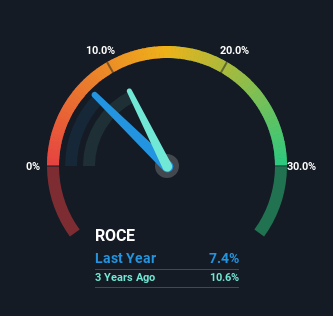- China
- /
- Electronic Equipment and Components
- /
- SHSE:688777
Capital Allocation Trends At SUPCON Technology (SHSE:688777) Aren't Ideal
To find a multi-bagger stock, what are the underlying trends we should look for in a business? Amongst other things, we'll want to see two things; firstly, a growing return on capital employed (ROCE) and secondly, an expansion in the company's amount of capital employed. If you see this, it typically means it's a company with a great business model and plenty of profitable reinvestment opportunities. However, after investigating SUPCON Technology (SHSE:688777), we don't think it's current trends fit the mold of a multi-bagger.
What Is Return On Capital Employed (ROCE)?
Just to clarify if you're unsure, ROCE is a metric for evaluating how much pre-tax income (in percentage terms) a company earns on the capital invested in its business. To calculate this metric for SUPCON Technology, this is the formula:
Return on Capital Employed = Earnings Before Interest and Tax (EBIT) ÷ (Total Assets - Current Liabilities)
0.074 = CN¥750m ÷ (CN¥17b - CN¥7.4b) (Based on the trailing twelve months to March 2024).
Therefore, SUPCON Technology has an ROCE of 7.4%. In absolute terms, that's a low return, but it's much better than the Electronic industry average of 5.2%.
View our latest analysis for SUPCON Technology

Above you can see how the current ROCE for SUPCON Technology compares to its prior returns on capital, but there's only so much you can tell from the past. If you'd like to see what analysts are forecasting going forward, you should check out our free analyst report for SUPCON Technology .
What Does the ROCE Trend For SUPCON Technology Tell Us?
In terms of SUPCON Technology's historical ROCE movements, the trend isn't fantastic. Over the last five years, returns on capital have decreased to 7.4% from 20% five years ago. Although, given both revenue and the amount of assets employed in the business have increased, it could suggest the company is investing in growth, and the extra capital has led to a short-term reduction in ROCE. If these investments prove successful, this can bode very well for long term stock performance.
On a side note, SUPCON Technology has done well to pay down its current liabilities to 42% of total assets. So we could link some of this to the decrease in ROCE. What's more, this can reduce some aspects of risk to the business because now the company's suppliers or short-term creditors are funding less of its operations. Since the business is basically funding more of its operations with it's own money, you could argue this has made the business less efficient at generating ROCE. Either way, they're still at a pretty high level, so we'd like to see them fall further if possible.
What We Can Learn From SUPCON Technology's ROCE
In summary, despite lower returns in the short term, we're encouraged to see that SUPCON Technology is reinvesting for growth and has higher sales as a result. And there could be an opportunity here if other metrics look good too, because the stock has declined 52% in the last three years. So we think it'd be worthwhile to look further into this stock given the trends look encouraging.
On a final note, we found 2 warning signs for SUPCON Technology (1 is potentially serious) you should be aware of.
For those who like to invest in solid companies, check out this free list of companies with solid balance sheets and high returns on equity.
New: Manage All Your Stock Portfolios in One Place
We've created the ultimate portfolio companion for stock investors, and it's free.
• Connect an unlimited number of Portfolios and see your total in one currency
• Be alerted to new Warning Signs or Risks via email or mobile
• Track the Fair Value of your stocks
Have feedback on this article? Concerned about the content? Get in touch with us directly. Alternatively, email editorial-team (at) simplywallst.com.
This article by Simply Wall St is general in nature. We provide commentary based on historical data and analyst forecasts only using an unbiased methodology and our articles are not intended to be financial advice. It does not constitute a recommendation to buy or sell any stock, and does not take account of your objectives, or your financial situation. We aim to bring you long-term focused analysis driven by fundamental data. Note that our analysis may not factor in the latest price-sensitive company announcements or qualitative material. Simply Wall St has no position in any stocks mentioned.
Have feedback on this article? Concerned about the content? Get in touch with us directly. Alternatively, email editorial-team@simplywallst.com
About SHSE:688777
Supcon TechnologyLtd
Provides industrial automation and intelligent manufacturing solutions worldwide.
Excellent balance sheet with limited growth.
Market Insights
Community Narratives



